New Stanford course transports students into the Middle Ages through food, music, dance
As part of a new humanities course, undergraduate students replicate the recipes and the ambience of ancient feasts in order to learn about how people lived in the Middle Ages.
Every Friday evening during the winter quarter, a group of undergraduate students donned white hats and aprons and gathered inside Stanford’s Teaching Kitchen at the Arrillaga Family Dining Commons.
Go to the web site to view the video.
The kitchen bustled with activity as the students chopped and mixed ingredients inside shiny metal pots and pans as they hurried to prepare an ancient feast.
As part of a new Stanford course, called Food, Text, Music: A Multidisciplinary Lab on the Art of Feasting, students deciphered old recipes, cooked unfamiliar dishes and learned and performed poetry and music from the 14th and 15th centuries.
Marisa Galvez, associate professor of French and Italian, and Jesse Rodin, associate professor of music, taught the class for the first time this year. Their experiential approach was designed to excite students about history.
“Interpreting the senses of the Middle Ages by experiencing the multi-sensory feast – cooking, tasting and smelling food, listening to music and making banquet table theatricals – captivates the students and entices their curiosity about that historical period,” Galvez said. “I’ve found that this has been an effective way to bring the students closer to the Middle Ages.”
Medieval cuisine and cookbooks
The way medieval people ate and thought about food differed from the modern understanding of meals, Galvez said.
During that time, the idea of humoral physiology, which was a widely held belief that the balance of four distinct bodily fluids, or humors, composed an individual’s temperament, influenced the way people cooked and ate. Foods were classified as hot, dry, moist or cold, and balancing those four categories in each dish was considered important for one’s health and well-being, Galvez said.
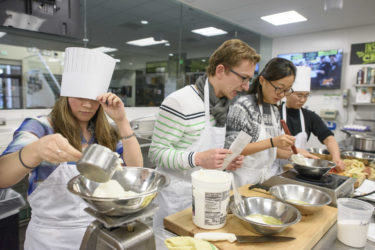
Image credit: L.A. Cicero
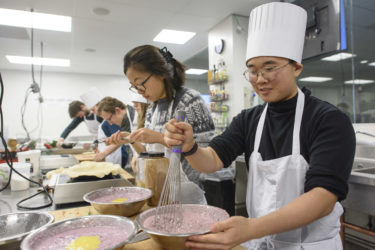
Image credit: L.A. Cicero
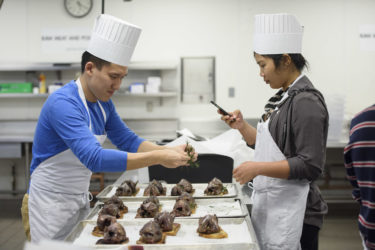
Image credit: L.A. Cicero

Image credit: L.A. Cicero
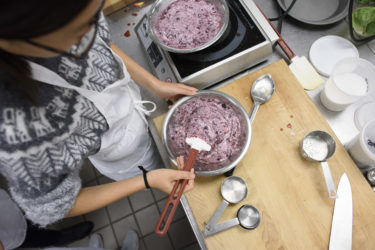
Image credit: L.A. Cicero

Image credit: L.A. Cicero

Image credit: L.A. Cicero
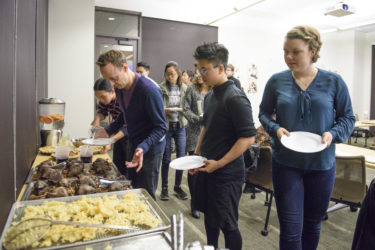
Image credit: L.A. Cicero

Image credit: L.A. Cicero
The recipes did not contain a lot of sugar or refined ingredients, and certain spices were rare and expensive even for the upper class. Game birds, such as pheasants, grouse and geese, were commonly served.
In addition, medieval people’s palates were different. Students were surprised at the very sour and peppery taste of the sauces that were served with the meat dishes.
“The idea that a cabbage soup was supposed to taste like cabbage – that didn’t come until much later,” Galvez said.
Recreating the recipes is a challenging process because medieval cookbooks were not detailed. The recorded recipes were not meant for novice cooks, but as a general guide for other chefs. So Galvez and Rodin took some time each class to discuss with students how much of a certain ingredient or spice may have been used and how certain dishes may have been prepared.
“By today’s standards medieval recipes are woefully imprecise,” Rodin said. “But we must remember that these cookbooks were written by experts for experts; there was no need to explain how much sugar to add because the chefs who used these texts would have already developed a sense for quantities after years of practice. For us moderns, there is value in trying to follow their directions as closely as possible. Engaging dynamically with these texts can help us understand what it meant to cook and eat during this period.”
Feasts were accompanied by artistic and musical performances, called “entremets” – in Old French, literally “between servings” – which students also learned and performed while eating food without the help of forks. Personal knives were used while dining, but forks didn’t catch on until after the reign of Queen Elizabeth.
The course also delves into the topics of food sustainability, colonialism and the politics of global food markets.
“Today, imported spices are standard fare on supermarket shelves,” Rodin said. “Consumers in the 14th and 15th centuries also relied on a dynamic spice trade – but spices and other imported ingredients were more expensive and more exclusive.”
Learning by doing
Some students said they appreciated the opportunity to learn about the Middle Ages not just by reading about the period but also by experiencing some parts of it.
Freshman Emma Grover said she enjoyed learning the differences between modern and medieval cuisine.
“We think of food in flavors,” Grover said. “But back then there was this sense of balance cooks tried to achieve in a dish by combining flavors that are opposites. So you’d often end up with a dish that has this multitude of very different flavors, which isn’t something we encounter much today.”
Grover said some of her favorite dishes to make as part of the class were an apple omelet and rose pudding.
“It’s amazing when everything comes together,” freshman Peicun Jiang said of recreating feasts in class. “It engages all five senses. Every week I experience an extravagant sensuous symphony.”
Jiang, who is considering majoring in economics or computer science, said he took the class because he has always been passionate about food.
He said one of his favorite parts of the class was handling ingredients he’s never seen or tried before, such as game birds. He said he was also surprised to see Southeast Asian spices like nutmeg and West African spices like grains of paradise in many of the medieval recipes.
“It was intriguing to see the amount of globalization that was already going on back then,” Jiang said.
Jiang said he believes recreating and analyzing the recipes from the past opens a door to a better understanding of what it was like to live during the Middle Ages.
“It’s only when we purge ourselves of our modern thinking, expectations and rules that we can truly walk in the shoes of medieval people and experience life like they experienced,” Jiang said. “Nelle Harper Lee wrote in To Kill a Mockingbird: ‘You never really understand a person until you consider things from his point of view … until you climb into his skin and walk around in it.’ For history and culture, it is exactly the same.”
